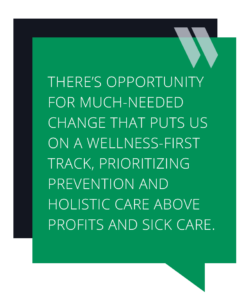Healthcare in the US is presently balanced on a knife’s edge.
In one direction, the path we’re currently on: costs that outpace all reason, a population that’s getting older and sicker, and chronic conditions that are practically endemic.
In the other, there’s opportunity for much-needed change that puts us on a wellness-first track, prioritizing prevention and holistic care above profits and sick care.
There is a rich opportunity for transformation made possible by the convergence of particular trends: the emergence of digital health, more robust communications technology, increased patient desire for telehealth, and the relaxing of governmental barriers to alternative modes of care.
There is a strong, even unassailable, case to be made that this kind of large-scale shift is necessary. The facts paint a bleak future if our paradigm doesn’t substantially shift:

Meanwhile, the medical profession itself is undergoing its own struggles, with the most salient being a looming shortage of clinicians. In 2034 – again, the same year seniors will be the largest generation in the country – one industry group puts that shortfall between 37,800 to 124,000 doctors. If you consider that currently, 50 percent of doctors are experiencing burnout and the majority say they’re not spending time on work they consider meaningful, it’s clear that the medical community is not structurally supported for the requirements of today – much less the needs of tomorrow.
But if the picture is presently beset by complexities, it doesn’t mean there’s no opportunity to reverse course and simplify healthcare for patients, for doctors, for the better. In fact, quite the opposite. With technology that helps care teams stay connected and proactive, with new models that reward outcomes and prevention, and new modes of care delivery, there is every reason for optimism.
We – as technologists, as clinicians and care teams, as policymakers and regulators, as healthcare startups – are primed to tip healthcare in the right direction. We just need to continue the good momentum.
Over the past few years, we’ve seen viable alternative models of care emerge, many digital-first and telehealth focused. These have especially proven useful with healthcare issues that aren’t one-and-done but rather require a more long-term and hands-on approach. Behavioral and mental health startups have demonstrated a real understanding that patients need frequent check-ins, non-judgmental support, and evidence-based counseling options. And it’s not restricted to mental health but any category that benefits from an integrated approach. Think about diabetes, for instance, which requires ongoing monitoring and whose patients benefit from the typical clinical support but also also the guidance of nutritionists, pharmacists, trainers, and more.
One new virtual women’s health company, for instance, blends education, pelvic floor therapy, nutrition, and mental health support to treat the whole person. Another musculoskeletal company uses AI and machine learning to help assess patients and route them to what they need most, which is often physical therapy and exercise over complex, costly surgeries. Another is using new technological approaches – like machine learning – in dermatology but also with an integrated bent that also brings in elements like nutrition and education to treat, in essence, the body and the mind. In nearly every case, mental health is a primary element because, as research has shown, care becomes phenomenally more effective when we acknowledge the mind’s powerful influence over health outcomes.
This is an exciting moment for healthcare. Newer, more effective models that target early detection, focused on preventative and continuous management to keep chronic conditions controlled can advance the cause of a much healthier population – more cost effectively and with less caregiver burnout too.
That’s something to celebrate – and to champion.



